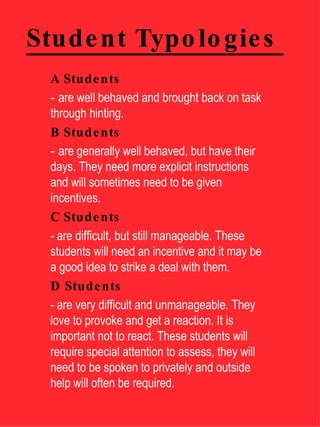Recommended
Recommended
More Related Content
Viewers also liked
Viewers also liked (7)
Frequently Asked Questions for Recruiting Hiring Training and Retaining Wound...

Frequently Asked Questions for Recruiting Hiring Training and Retaining Wound...
More from nvall101
More from nvall101 (20)
Student typologies
- 1. A Students - are well behaved and brought back on task through hinting. B Students - are generally well behaved, but have their days. They need more explicit instructions and will sometimes need to be given incentives. C Students - are difficult, but still manageable. These students will need an incentive and it may be a good idea to strike a deal with them. D Students - are very difficult and unmanageable. They love to provoke and get a reaction. It is important not to react. These students will require special attention to assess, they will need to be spoken to privately and outside help will often be required. Student Typologies

